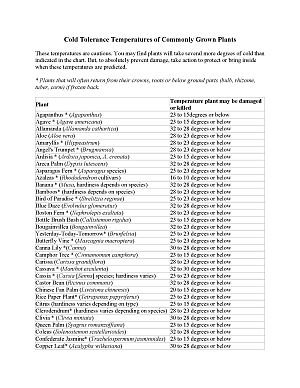by Dan Gill
Check the local weather before reading this article.
If you look around at some of our landscapes, particularly in south Louisiana, you would think we live in the tropics. Indeed, some winters the temperature never does dip much below the mid to upper twenties, allowing tropicals to survive. Despite the overall relative mildness of our winters, severe freezes do occur, and they can be devastating to tropical plants growing in our landscapes. All it takes is one night of temperatures in the mid to low twenties to severely damage or kill many tropicals. Despite the possibility of sometimes severe freezes, Louisiana gardeners still cling to the use of tropical plants in the landscape. I wouldn’t give mine up either. Nothing else performs as well as tropical plants during the intense heat of summer. But it does mean that we sometimes need to help these plants to survive when freezes do occur.
Hardy vs Tender
Two terms are used when it comes to the ability of a plant to tolerate cold. If a plant will endure temperatures 32°or below with no damage, it is termed hardy. There are degrees of hardiness. A plant that will tolerate a temperature of 15° is hardier than one that will be killed at temperatures below 25°. Our commonly used landscape plants, including trees, shrubs, groundcovers, lawns and vines, are hardy to at least 10 or 15 degrees and will not be damaged by typical winter weather. The term tender refers to plants that are killed or severely damaged by temperatures of 32° or below. Surprisingly, many tropical plants are more cold-tolerant than we give them credit for and will tolerate light freezes where the temperatures dip briefly below freezing. But you do run a risk leaving them out or not covering them on nights when even light freezes occur. Many tropicals may survive a hard freeze (temperatures in the mid twenties and below-freezing temperatures lasting most of the night) by coming back from their lower trunk, crown, roots or below-ground parts (tubers, bulbs, rhizomes). Since the ground in south Louisiana does not freeze, plant parts at or below the soil surface often survive.
Types of Freezes
When freezes do come, they can be characterized as radiational or advective. Radiational freezes or frosts occur on calm, clear nights when heat radiates into the environment from surfaces or objects. These freezes are generally considered light and primarily damage the foliage of tropicals. Plant damage from a radiational freeze can be minimized by reducing radiant heat loss from plant and soil surfaces. Advective freezes occur when cold air masses move down from northern regions, causing a drastic drop in temperature. Windy conditions are normal during advective freezes. Although radiant heat loss also occurs during an advective freeze, the conditions are quite different from a radiational freeze. The temperatures tend to be much lower and are liable to last longer during advective freezes, and protecting tropicals is more difficult.
Factors Influencing Cold Injury
The most important factors in how much damage a plant receives from cold are how hardy it is and how cold it gets. There are, however, a surprising number of other factors that can play a big role in how much cold injury occurs.
Make sure good care is given to your landscape during the summer growing season. Plants, even hardy ones, doing poorly or in low vigor are more susceptible to cold damage. Pruning and fertilizing hardy trees, shrubs and groundcovers should be avoided after September, as this can stimulate late growth, which is not as cold-hardy and may lead to freeze injury.
A sudden drop to below-freezing temperatures from a period of relatively mild weather may cause damage even to hardy plants that might otherwise have suffered little or no damage. A gradual decrease in temperature over a period of time will harden off plants, allowing them to withstand freezing temperatures better. This is not true for especially tender plants, as they will not tolerate freezing temperatures regardless of the preceding temperatures. The longer below-freezing temperature persist, the more likely damage is to occur. This is because as time goes by, heat stored in plants, soil, walls, etc. that initially moderates temperatures around the plant is lost. Freezes that last 8 hours or more are particularly damaging to tender plants. Finally, where a tropical plant is located in the landscape can make a big difference in how much damage occurs. The careful placement of tender or less-hardy plants in sheltered areas that block cold north winds and trap the heat of the sun can help them survive freezes. Planting in areas covered with overhangs or tree canopies will also help to minimize cold damage.
What to do before a freeze
- Water. Thoroughly watering landscape plants before a freeze may reduce the change of freeze damage. Many times cold weather is accompanied by strong, dry winds. These winds may cause damage by drying plants out, and watering helps to prevent this. Wetting the foliage of plants before a freeze does not, however, provide any cold protection. A well-watered soil will also absorb more solar radiation than dry soil and will re-radiate the heat during the night.
- Move inside. Move all tender plants in containers and hanging baskets into buildings where the temperature will stay above freezing. If this is not possible, group all container plants in a protected area (like the inside corner of a covered patio) and cover them with plastic. If plants are kept inside for extended periods, make sure they receive as much light as possible.
- Mulch. For plants growing in the ground, mulches can help protect them. Use a loose, dry material such as pine straw or leaves. You should be aware that mulches will only protect what they cover. Mulch at the base of a bird-of-paradise will help the roots, but will provide no added protection to the leaves. Mulches, then, are best used to protect below-ground parts or crowns or may be used to completely cover low-growing plants to a depth of four inches. Leave complete cover on no more than three or four days.
- Cover. If they are not too large, individual plants can be protected by covering them with various sized cardboard or Styrofoam boxes.
Larger plants can be protected by creating a simple structure and covering it with sheets, quilts or plastic. The structure holds the covering off the foliage, preventing branch breakage and improving cold protection. It need be nothing more elaborate than three stakes slightly taller than the plant driven into the ground. The cover should extend to the ground and be sealed with soil, stones or bricks. Plastic covers should be vented or removed on sunny, warm days. The covers will work best for radiational freezes by preventing or blocking heat loss. The extreme, prolonged cold that occurs during advective freezes is not so easily dealt with. Many plants will still die even with protection. This can be helped by providing a heat source under the covering. A safe, easy way to do this is to generously wrap or drape the plant with small outdoor Christmas lights. The lights provide heat but do not get hot enough to burn the plant or cover. Please be careful and use only outdoor extension cords and sockets.
If necessary, you may prune back a large plant, like a hibiscus, to make its size more practical to cover. For trees, such as citrus, that are too large to cover, you may at least want to wrap the trunk with an insulating material such as foam rubber or blankets. Even if the top dies, you may be able to regrow the tree from the surviving trunk. If you are growing vegetables, harvest any broccoli, cauliflower, fava beans or peas that are ready. Freezing temperatures will not hurt the plants but can damage the heads, pods and flowers. Also, any citrus fruit should be harvested from the tree prior to a hard freeze.
What to do after a freeze
After a freeze is over, check the water needs of plants in containers and in the ground. Unless you are keeping them inside for the rest of the winter, move container plants back to their spots outside. For plants that you covered, remove or vent clear plastic covers to prevent excessive heat buildup if the next day is sunny and mild. You do not need to completely remove the cover if it will freeze again the next night. You may leave plants covered with blankets or sheets for several days without harming them, but eventually the covers will need to be removed so they can get light.
Do not prune anything for several days after a freeze. It often takes several days for all of the damage to become evident. Damaged growth on herbaceous or nonwoody plants, such as cannas, elephant ears, birds-of-paradise, begonias, impatiens, philodendron and gingers, may be pruned away back to living tissue. This pruning is optional and is done more to neaten things up than to benefit the plants. However, if the damaged tissue is oozy, mushy, slimy and foul smelling, it should be removed. You may remove the damaged foliage from banana trees, but do not cut back the trunk unless you can tell for sure that it has been killed. It will look brown, feel mushy, feel loose in the soil and will bleed a lot if punctured. The exception would be any banana trees that produced a bunch of fruit last year. They will not send up any more new growth and should be cut to the ground to make room for new shoots that will come up this summer.
Generally, it’s a good idea to delay hard pruning of woody tropical plants, such as hibiscus, tibouchina, angel trumpet, croton, ixora, schefflera, copper plant and rubber tree, until new growth begins in the spring and you can more accurately determine which parts are alive and what is dead. Dead leaves on woody tropical plants can be picked off to make things look neater. If you can clearly determine what branches are dead on a woody plant, you can prune them back. Try scratching the bark with your thumbnail. If the tissue underneath is green, it’s still alive. If the tissue is tan or brown, the branch is dead. Start at the top and work your way down to see how far back the plant was killed.
Tropical and sub-tropical plants can be used effectively in the landscape, but they must be protected or replaced when necessary. The best idea is to plant a good combination of tender and hardy plants, so that your landscape is not totally devastated in the event of extremely cold weather.
Copyright LSU AgCenter
Please see the attached file for a table listing commonly grown plants and their cold-tolerance temperatures.


